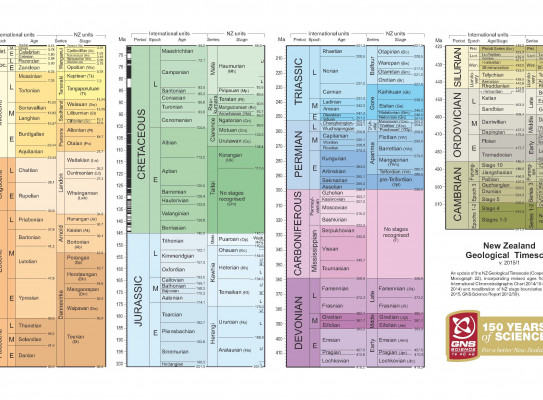New geological timescale builds on decades of research

Scientists have produced an updated geological timescale for New Zealand going back 540 million years to a period known as the Cambrian.
Timescales are the framework that scientists use to date and classify rock formations, life forms, and geological events. Scientists rely heavily on them to describe the timing and relationships between events that have occurred in the Earth’s evolution.
In particular, timescales assign a geological age to rocks, fossils, and minerals and are used for working out rates of geological processes and events such as earthquakes, eruptions, submergence, uplift, erosion, sea-level change, climate history, biodiversity change, and organic evolution.
Timescales play a crucial role in the search for petroleum and other minerals, and therefore their accuracy has economic implications.
The New Zealand Geological Timescale is revised periodically to take account of advances in science and in age-dating techniques in particular.
The new time scale, produced by nine palaeontologists at GNS Science, recalibrates ages and boundaries between no fewer than 11 different periods, dozens of epochs, and scores of stages. The latter being the briefest age brackets, measured in millions or hundreds of thousands of years rather than tens of millions of years which characterise periods.
The scale ranges from New Zealand’s oldest rocks formed about 500 million years ago to the most recent period known as the Quaternary, which spans from 2.6 million years ago to the present. This is one of the best studied parts of the geological record, mainly because it is well preserved.

The timescale is the standard reference for all geological activity in New Zealand and is used by thousands of people each year, mostly scientists, both in New Zealand and internationally.
Lead author of the new timescale, palaeontologist Ian Raine, said there were changes and refinements throughout the timescale from 540 million years ago to the present.
“There has been a wide range of contributions to the changes including new data, new fossil interpretations, and improved technology,” Dr Raine said.
The International Geological Timescale, which underwent a major upgrade in 2012, has also been incorporated into the updated New Zealand scale.
"New Zealand has sequences of rocks and fossils that are scientifically important in a global context, especially for the Mesozoic and Cenozoic eras [the last 252 million years].”
A focus of climate change research at GNS Science in recent years has been the Paleocene and Eocene epochs (66 to 34 million years ago), during which the Earth warmed after the end-Cretaceous meteor impact event (which saw the demise of the dinosaurs) to a tropical peak, then cooled as ice sheets began to develop in Antarctica.
Scientists were investigating the causes of these climate changes, and this work required close attention to dating and correlation of events between different regions.
In New Zealand, this work has also led to a greater understanding of how the interplay of changing climate and sea level affected deposition of sediments in the Taranaki Basin, forming petroleum source rocks and reservoirs.